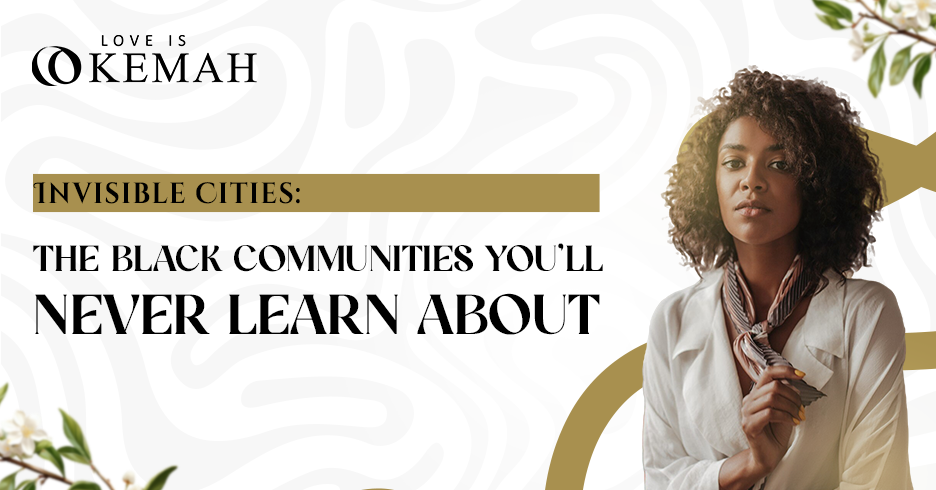
Invisible Cities: The Black Communities You’ll Never Learn About
Have you ever wondered how many stories of resilience, brilliance, and culture remain buried beneath the surface of mainstream history?
In the shadow of towering skyscrapers and within the folds of history books lies a treasure trove of untold stories—invisible cities inhabited by Black communities that shaped the world as we know it today. These are not cities hidden on maps, but rather pockets of history that exist beyond the gaze of popular narratives. They are the heartbeats of innovation, creativity, and strength that deserve to be remembered, celebrated, and shared.
The Forgotten Bastions of Progress
Take, for instance, the Greenwood District of Tulsa, Oklahoma, affectionately known as “Black Wall Street.” A beacon of Black excellence in the early 20th century, this community was home to thriving businesses, schools, and cultural institutions. It stood as a testament to what Black communities could achieve despite systemic racism and segregation. However, the devastating Tulsa Race Massacre of 1921 reduced it to ashes, erasing much of its brilliance from mainstream discourse.
Or consider Nicodemus, Kansas, a town established by formerly enslaved African Americans seeking a new beginning after the Civil War. This community flourished as a symbol of self-determination and hope. While it still exists today, its story is rarely told, overshadowed by more dominant narratives.
Why Are These Stories Invisible?
The erasure of these communities from mainstream history is no accident. Systemic racism, cultural biases, and a reluctance to confront uncomfortable truths have all contributed to the invisibility of these Black enclaves. Moreover, the achievements of these communities often challenge the prevailing stereotypes about Black capabilities and resilience, making them inconvenient truths for a society still grappling with inequality.
The Vibrancy That Persists
Despite the odds, many Black communities continue to thrive, creating spaces where culture, innovation, and activism intersect. The Gullah Geechee culture of the southeastern United States, for instance, is a living example of how Black communities have preserved their African heritage against all odds. Their unique language, cuisine, and traditions offer a vibrant lens into a history that refuses to be forgotten.
Similarly, the Black neighborhoods of cities like Detroit, Chicago, and Atlanta have long been hubs of creativity and activism. From the Motown sound that revolutionized music to the civil rights movements that reshaped America, these communities have consistently been at the forefront of change.
Unveiling the Invisible
Uncovering these hidden histories is not just about rewriting the past; it’s about reclaiming a narrative that has been deliberately obscured. Here are some ways we can bring these invisible cities to light:
- Education: Incorporating the stories of Black communities into school curriculums is a critical step. These histories should be taught alongside traditional narratives to provide a more holistic understanding of the past.
- Storytelling Platforms: Documentaries, books, and digital media can serve as powerful tools to amplify these stories. From social media campaigns to in-depth documentaries, there are endless possibilities for making these histories accessible.
- Community Engagement: Visiting these places, supporting local businesses, and engaging with their histories can help keep these stories alive. Experiencing the vibrancy of these communities firsthand fosters a deeper connection to their legacy.
- Preservation Efforts: Historic landmarks, museums, and cultural centers dedicated to these communities need funding and support to ensure their stories endure for generations to come.
Why It Matters
The stories of invisible Black cities are not just about the past; they’re about the present and the future. Understanding these histories can reshape how we see the world, offering a richer, more inclusive perspective. It challenges stereotypes, fosters empathy, and underscores the resilience of Black communities.
Moreover, celebrating these stories sends a powerful message: that every community, no matter how marginalized, has the potential to contribute to the greater tapestry of human achievement.
A Call to Action
As you finish reading this, ask yourself: What role can I play in uncovering and celebrating these invisible cities? Whether it’s through education, advocacy, or simply sharing these stories, every effort counts. The more we shine a light on these hidden histories, the less invisible they become.
Invisible cities are not just a testament to what has been lost but a reminder of what can be reclaimed. They are a call to action for us all to look beyond the surface, to dig deeper, and to ensure that these stories are not just remembered but revered.
